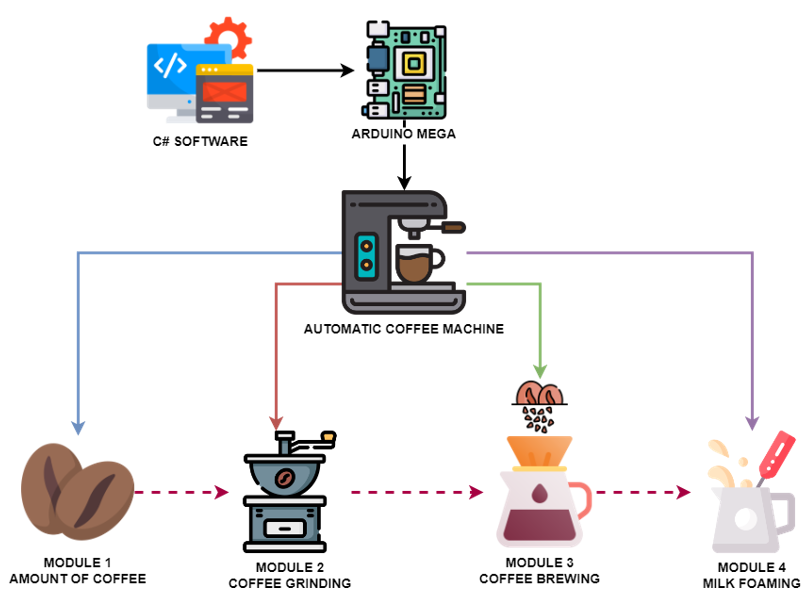Development of an Embedded System Based Prototype Automatic Coffee Machine and Detailed Analysis of Its Modules
DOI:
https://doi.org/10.58190/ijamec.2025.120Keywords:
coffee machine, coffee grinding, coffee brewing, milk frothing, embedded systemAbstract
Coffee is one of the most popular beverages in the world and has an important place in many cultures. With the developing technology, coffee preparation processes have also evolved and automatic coffee machines have entered our lives. These machines provide convenience and time savings to the user, while optimizing the ideal brewing conditions of the coffee and increasing the quality of its flavour. Modern automatic coffee machines have advanced systems that can precisely control the temperature of the water, the grinding degree of the coffee bean and the brewing time. Thus, coffee lovers can have a consistent and perfect coffee experience in every cup. This article comprehensively covers the design, construction and testing process of a prototype automatic coffee machine. First, the requirements and goals determined within the scope of the project were defined, then the components suitable for these requirements were selected. During the design phase, the focus was on basic functions such as adjusting the coffee strength (amount), grinding the coffee, heating the water, brewing time and frothing the milk. The electronic control unit was designed based on Arduino Mega and the various functions of the machine were performed automatically. The user interface is implemented with an application written in the C# programming language. This user interface has established communication with Arduino Mega and aims to enable the user to easily adjust brewing settings. Finally, the performance of the developed prototype has been evaluated with various tests, and detailed analyses have been made on the reliability and user-friendly design of the system. This study presents important findings regarding the design and development process of automatic coffee machines and aims to guide future studies.
Downloads
References
[1] Harris, H. and C. Brewster, The coffee-machine system: how international selection really works. International Journal of Human Resource Management, 1999. 10(3): p. 488-500.
[2] Hristov, V., M. Zhilevski, and D. Slavov. Design of Automated Coffee Machine through Verilog HDL. in 2022 International Symposium on Multidisciplinary Studies and Innovative Technologies (ISMSIT). 2022. IEEE.
[3] Olechno, E., et al., Impact of brewing methods on total phenolic content (TPC) in various types of coffee. Molecules, 2020. 25(22): p. 5274.
[4] Agustian, R., et al., Design of automatic coffee bean roaster based on Arduino Uno microcontroller. International Journal of Advances in Data and Information Systems, 2022. 3(2): p. 49-57.
[5] Hadianto, E., et al., Design and Development of Coffee Machine Control System Using Fuzzy Logic. Sinkron: jurnal dan penelitian teknik informatika, 2023. 7(1): p. 130-138.
[6] Sihab, R. and N. Yaqin, Design of Automatic Coffee and Milk-Making Machine Based on Arduino. SAINTEKBU, 2023. 15(02): p. 17-26.
[7] Brommer, E., B. Stratmann, and D. Quack, Environmental impacts of different methods of coffee preparation. International Journal of Consumer Studies, 2011. 35(2): p. 212-220.
[8] Pongswatd, S., K. Smerpitak, and T. Thepmanee, Smart coffee vending machine based on IoT concept. International Journal of Innovative Computing, Information and Control, 2020. 16(4): p. 1441-1448.
[9] Gomes, W.P.C., et al., Application of multispectral imaging combined with machine learning models to discriminate special and traditional green coffee. Computers and Electronics in Agriculture, 2022. 198: p. 107097.
[10] Ogunjirin, O.A., et al. Design and construction of an electrically powered coffee roasting machine. in IOP Conference Series: Earth and Environmental Science. 2020. IOP Publishing.
[11] de Figueiredo Tavares, M.P. and A.L. Mourad, Coffee beverage preparation by different methods from an environmental perspective. The International Journal of Life Cycle Assessment, 2020. 25: p. 1356-1367.
[12] Andreas, W., et al. Modification of Group Head Coffee Machine Using Reverse Engineering and VDI 2221 Methods. in Proceedings of the Second Asia Pacific International Conference on Industrial Engineering and Operations Management. 2021.
[13] Wulandari, B. and M.P. Jati, Design and Implementation of Real-Time Health Vital Sign Monitoring Device with Wireless Sensor-based on Arduino Mega. Elinvo (Electronics, Informatics, and Vocational Education), 2021. 6(1): p. 61-70.
[14] Zhang, K., et al., Construction of Medusa‐Like Adhesive Carbon Nanotube Array Induced by Deformation of Alumina Sheets. Small, 2024. 20(18): p. 2306722.
[15] Putri, A.Z., et al. Implementation of nema-17 stepper motor and SG-90 servo motor as mechanical drivers on spinal needle positioning test equipment. in 2023 IEEE International Biomedical Instrumentation and Technology Conference (IBITeC). 2023. IEEE.
[16] Peerzada, P., W.H. Larik, and A.A. Mahar, DC motor speed control through arduino and L298N motor driver using PID controller. International Journal of Electrical Engineering & Emerging Technology, 2021. 4(2): p. 21-24.
[17] Khamidah, M., et al., Activator Token KWh Meter Using Servo Motor SG90 Based on Arduino Uno Microcontroller. Journal of Energy, Material, and Instrumentation Technology, 2023. 4(2): p. 72-79.
[18] Prasojo, I., A. Maseleno, and N. Shahu, Design of automatic watering system based on Arduino. Journal of Robotics and Control (JRC), 2020. 1(2): p. 59-63.

Downloads
Published
Issue
Section
License
Copyright (c) 2025 International Journal of Applied Methods in Electronics and Computers

This work is licensed under a Creative Commons Attribution-ShareAlike 4.0 International License.




